Environmental and Cultural Tourism
VerifiedAdded on 2023/06/07
|6
|1003
|244
AI Summary
This article discusses the Canning Stock Route in Australia and its cultural heritage sites. It covers topics such as ownership, stakeholders, visitors' profiles, marketing strategies, current issues, and sustainable solutions. The article also highlights the need for protecting the environment and cultural heritage while promoting tourism.
Contribute Materials
Your contribution can guide someone’s learning journey. Share your
documents today.
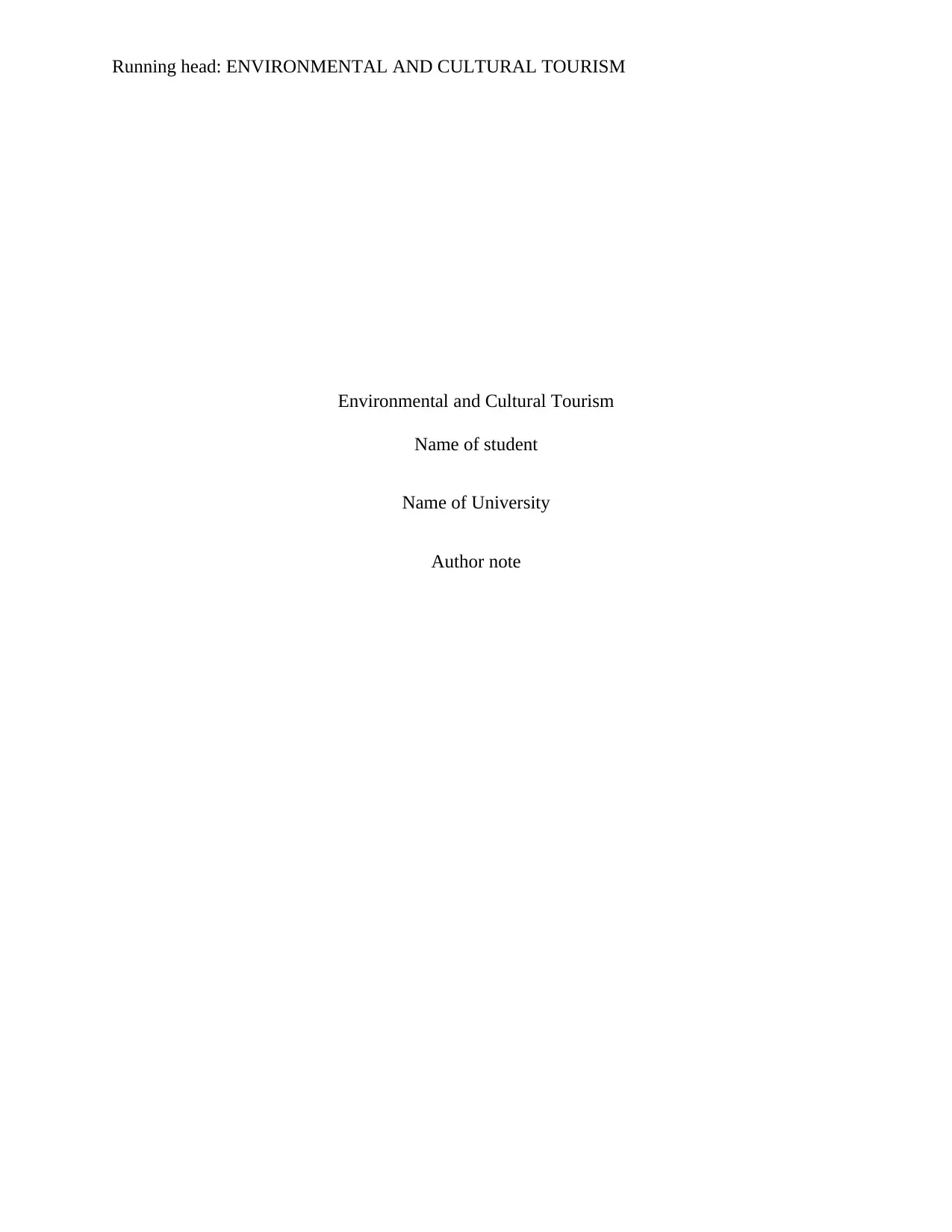
Running head: ENVIRONMENTAL AND CULTURAL TOURISM
Environmental and Cultural Tourism
Name of student
Name of University
Author note
Environmental and Cultural Tourism
Name of student
Name of University
Author note
Secure Best Marks with AI Grader
Need help grading? Try our AI Grader for instant feedback on your assignments.
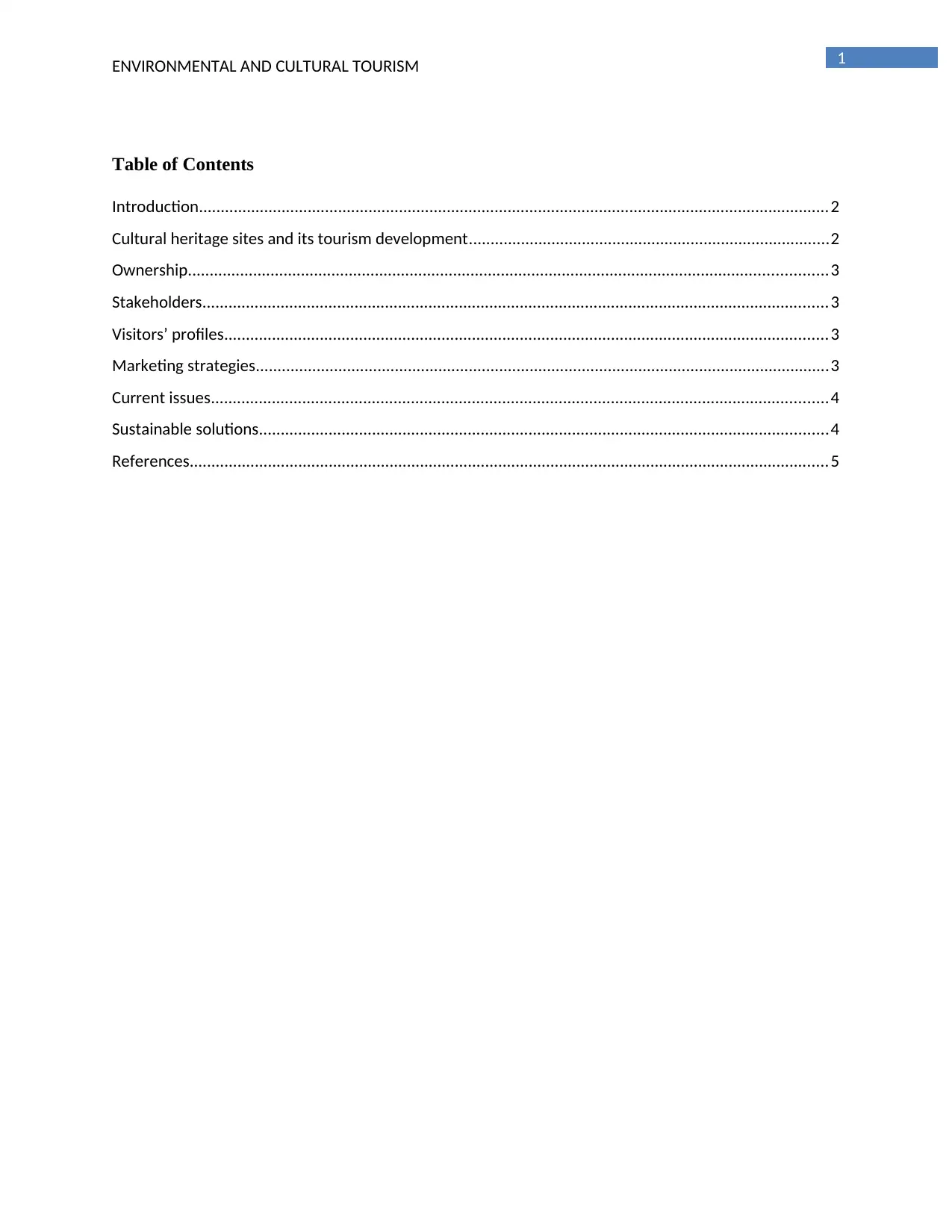
1ENVIRONMENTAL AND CULTURAL TOURISM
Table of Contents
Introduction.................................................................................................................................................2
Cultural heritage sites and its tourism development...................................................................................2
Ownership...................................................................................................................................................3
Stakeholders................................................................................................................................................3
Visitors’ profiles...........................................................................................................................................3
Marketing strategies....................................................................................................................................3
Current issues..............................................................................................................................................4
Sustainable solutions...................................................................................................................................4
References...................................................................................................................................................5
Table of Contents
Introduction.................................................................................................................................................2
Cultural heritage sites and its tourism development...................................................................................2
Ownership...................................................................................................................................................3
Stakeholders................................................................................................................................................3
Visitors’ profiles...........................................................................................................................................3
Marketing strategies....................................................................................................................................3
Current issues..............................................................................................................................................4
Sustainable solutions...................................................................................................................................4
References...................................................................................................................................................5
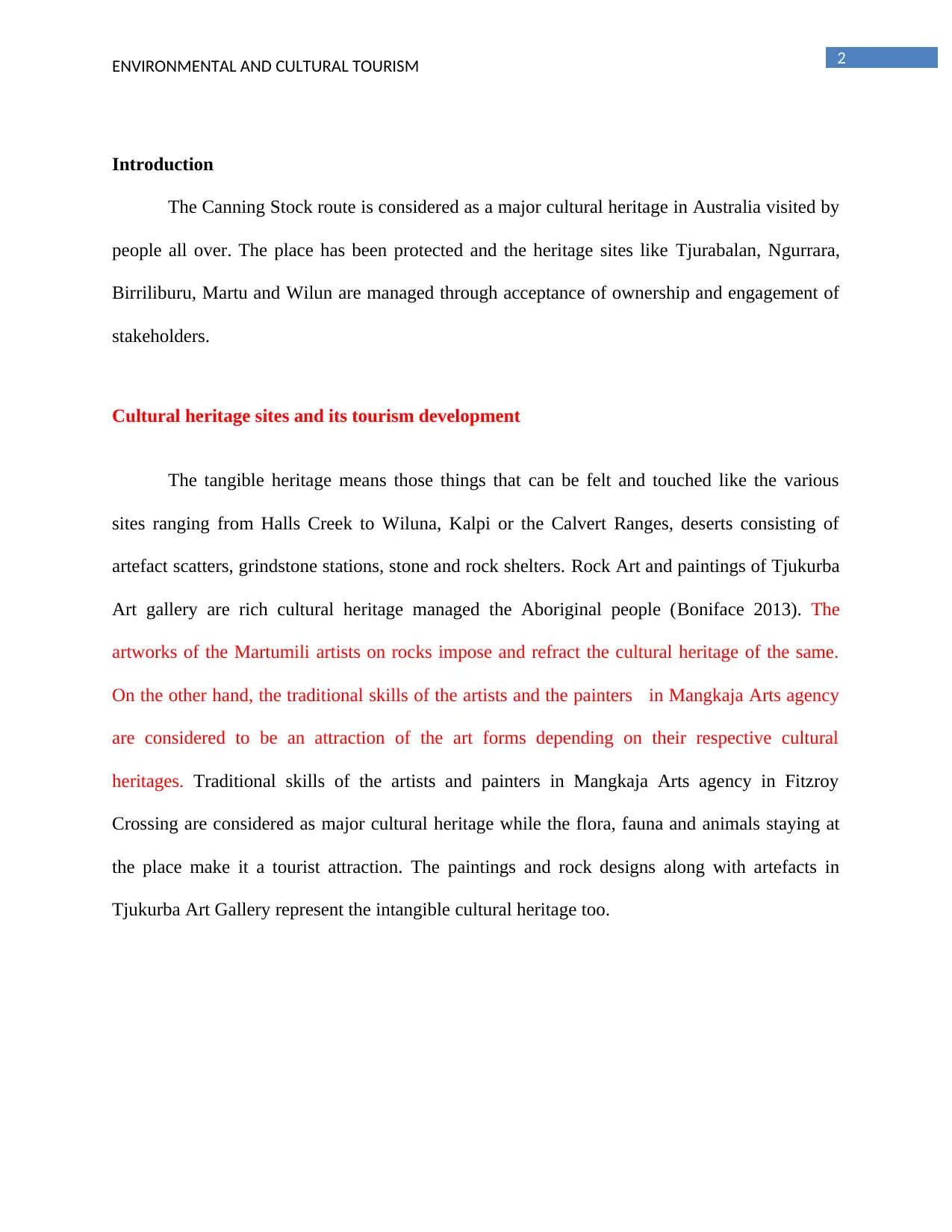
2ENVIRONMENTAL AND CULTURAL TOURISM
Introduction
The Canning Stock route is considered as a major cultural heritage in Australia visited by
people all over. The place has been protected and the heritage sites like Tjurabalan, Ngurrara,
Birriliburu, Martu and Wilun are managed through acceptance of ownership and engagement of
stakeholders.
Cultural heritage sites and its tourism development
The tangible heritage means those things that can be felt and touched like the various
sites ranging from Halls Creek to Wiluna, Kalpi or the Calvert Ranges, deserts consisting of
artefact scatters, grindstone stations, stone and rock shelters. Rock Art and paintings of Tjukurba
Art gallery are rich cultural heritage managed the Aboriginal people (Boniface 2013). The
artworks of the Martumili artists on rocks impose and refract the cultural heritage of the same.
On the other hand, the traditional skills of the artists and the painters in Mangkaja Arts agency
are considered to be an attraction of the art forms depending on their respective cultural
heritages. Traditional skills of the artists and painters in Mangkaja Arts agency in Fitzroy
Crossing are considered as major cultural heritage while the flora, fauna and animals staying at
the place make it a tourist attraction. The paintings and rock designs along with artefacts in
Tjukurba Art Gallery represent the intangible cultural heritage too.
Introduction
The Canning Stock route is considered as a major cultural heritage in Australia visited by
people all over. The place has been protected and the heritage sites like Tjurabalan, Ngurrara,
Birriliburu, Martu and Wilun are managed through acceptance of ownership and engagement of
stakeholders.
Cultural heritage sites and its tourism development
The tangible heritage means those things that can be felt and touched like the various
sites ranging from Halls Creek to Wiluna, Kalpi or the Calvert Ranges, deserts consisting of
artefact scatters, grindstone stations, stone and rock shelters. Rock Art and paintings of Tjukurba
Art gallery are rich cultural heritage managed the Aboriginal people (Boniface 2013). The
artworks of the Martumili artists on rocks impose and refract the cultural heritage of the same.
On the other hand, the traditional skills of the artists and the painters in Mangkaja Arts agency
are considered to be an attraction of the art forms depending on their respective cultural
heritages. Traditional skills of the artists and painters in Mangkaja Arts agency in Fitzroy
Crossing are considered as major cultural heritage while the flora, fauna and animals staying at
the place make it a tourist attraction. The paintings and rock designs along with artefacts in
Tjukurba Art Gallery represent the intangible cultural heritage too.

3ENVIRONMENTAL AND CULTURAL TOURISM
Ownership
The Aboriginal groups own the entire tourism and routes in the area while support has
been provided by the Royal Commission n in Australia. The ranger have managed the permit and
the Government along with regulatory agencies have protected the area. The diversity
management is possible with proper support by Government and under the WA Aboriginal
Heritage Act, 1972 (Briassoulis and Van Der Straaten 2013).
Stakeholders
Birriliburu rangers, Ngurrara rangers, Paruku rangers, Aboriginal people staying there
and also the tourism operators who manage the permits and entire tourism activities.
Visitors’ profiles
There are nearly 100000 visitors in the past few years and because of the focus on
preserving the cultural heritage, more people are visiting nowadays. The presence of rich flora
and and places to have a relaxing time near the desert areas make it a good place for people to
visit in (Calabrò and Della Spina 2014). The Royal Commission has used various measures to
treat the Aboriginal people staying there with dignity and ensure that any sort of unethical trade
practices are prevented.
Marketing strategies
The products here include the tourism activities while it is located in Australia’s Canning
Stock route. The promotions are done via online website from where the visitors can know about
the site and search for useful information about the tour. The marketing has been promoted
through the management of “Explore Australia” campaign by Four Wheel Drive. The prices of
Ownership
The Aboriginal groups own the entire tourism and routes in the area while support has
been provided by the Royal Commission n in Australia. The ranger have managed the permit and
the Government along with regulatory agencies have protected the area. The diversity
management is possible with proper support by Government and under the WA Aboriginal
Heritage Act, 1972 (Briassoulis and Van Der Straaten 2013).
Stakeholders
Birriliburu rangers, Ngurrara rangers, Paruku rangers, Aboriginal people staying there
and also the tourism operators who manage the permits and entire tourism activities.
Visitors’ profiles
There are nearly 100000 visitors in the past few years and because of the focus on
preserving the cultural heritage, more people are visiting nowadays. The presence of rich flora
and and places to have a relaxing time near the desert areas make it a good place for people to
visit in (Calabrò and Della Spina 2014). The Royal Commission has used various measures to
treat the Aboriginal people staying there with dignity and ensure that any sort of unethical trade
practices are prevented.
Marketing strategies
The products here include the tourism activities while it is located in Australia’s Canning
Stock route. The promotions are done via online website from where the visitors can know about
the site and search for useful information about the tour. The marketing has been promoted
through the management of “Explore Australia” campaign by Four Wheel Drive. The prices of
Secure Best Marks with AI Grader
Need help grading? Try our AI Grader for instant feedback on your assignments.
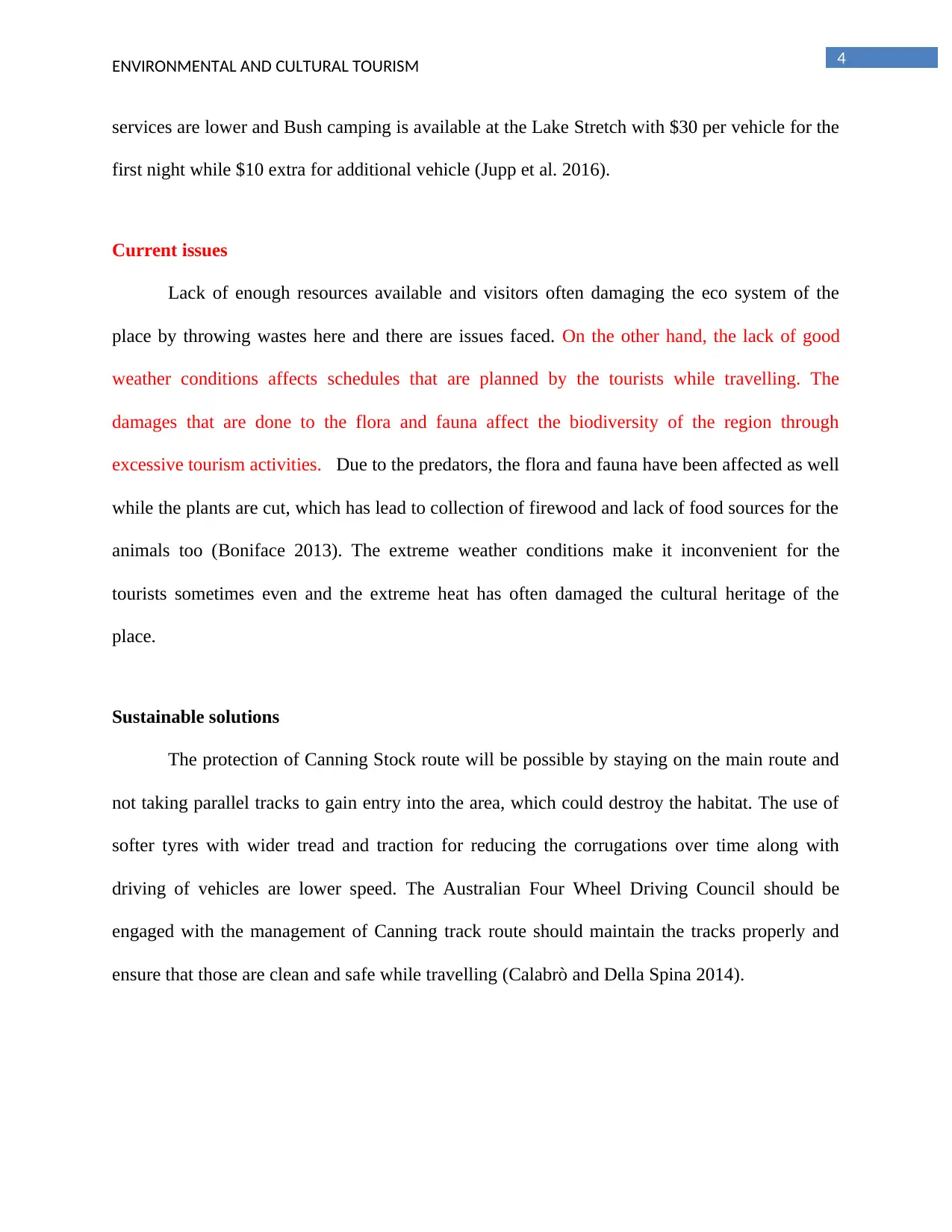
4ENVIRONMENTAL AND CULTURAL TOURISM
services are lower and Bush camping is available at the Lake Stretch with $30 per vehicle for the
first night while $10 extra for additional vehicle (Jupp et al. 2016).
Current issues
Lack of enough resources available and visitors often damaging the eco system of the
place by throwing wastes here and there are issues faced. On the other hand, the lack of good
weather conditions affects schedules that are planned by the tourists while travelling. The
damages that are done to the flora and fauna affect the biodiversity of the region through
excessive tourism activities. Due to the predators, the flora and fauna have been affected as well
while the plants are cut, which has lead to collection of firewood and lack of food sources for the
animals too (Boniface 2013). The extreme weather conditions make it inconvenient for the
tourists sometimes even and the extreme heat has often damaged the cultural heritage of the
place.
Sustainable solutions
The protection of Canning Stock route will be possible by staying on the main route and
not taking parallel tracks to gain entry into the area, which could destroy the habitat. The use of
softer tyres with wider tread and traction for reducing the corrugations over time along with
driving of vehicles are lower speed. The Australian Four Wheel Driving Council should be
engaged with the management of Canning track route should maintain the tracks properly and
ensure that those are clean and safe while travelling (Calabrò and Della Spina 2014).
services are lower and Bush camping is available at the Lake Stretch with $30 per vehicle for the
first night while $10 extra for additional vehicle (Jupp et al. 2016).
Current issues
Lack of enough resources available and visitors often damaging the eco system of the
place by throwing wastes here and there are issues faced. On the other hand, the lack of good
weather conditions affects schedules that are planned by the tourists while travelling. The
damages that are done to the flora and fauna affect the biodiversity of the region through
excessive tourism activities. Due to the predators, the flora and fauna have been affected as well
while the plants are cut, which has lead to collection of firewood and lack of food sources for the
animals too (Boniface 2013). The extreme weather conditions make it inconvenient for the
tourists sometimes even and the extreme heat has often damaged the cultural heritage of the
place.
Sustainable solutions
The protection of Canning Stock route will be possible by staying on the main route and
not taking parallel tracks to gain entry into the area, which could destroy the habitat. The use of
softer tyres with wider tread and traction for reducing the corrugations over time along with
driving of vehicles are lower speed. The Australian Four Wheel Driving Council should be
engaged with the management of Canning track route should maintain the tracks properly and
ensure that those are clean and safe while travelling (Calabrò and Della Spina 2014).
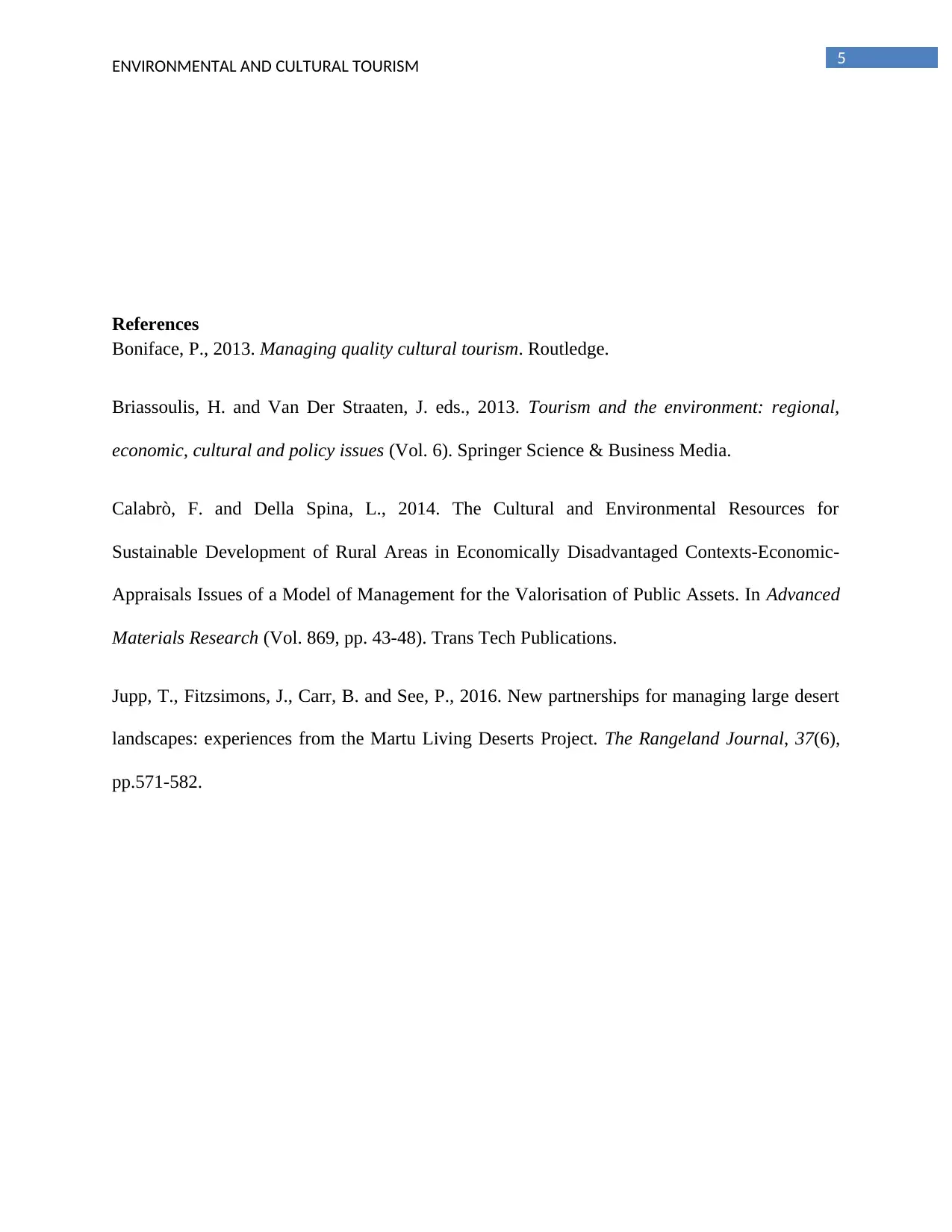
5ENVIRONMENTAL AND CULTURAL TOURISM
References
Boniface, P., 2013. Managing quality cultural tourism. Routledge.
Briassoulis, H. and Van Der Straaten, J. eds., 2013. Tourism and the environment: regional,
economic, cultural and policy issues (Vol. 6). Springer Science & Business Media.
Calabrò, F. and Della Spina, L., 2014. The Cultural and Environmental Resources for
Sustainable Development of Rural Areas in Economically Disadvantaged Contexts-Economic-
Appraisals Issues of a Model of Management for the Valorisation of Public Assets. In Advanced
Materials Research (Vol. 869, pp. 43-48). Trans Tech Publications.
Jupp, T., Fitzsimons, J., Carr, B. and See, P., 2016. New partnerships for managing large desert
landscapes: experiences from the Martu Living Deserts Project. The Rangeland Journal, 37(6),
pp.571-582.
References
Boniface, P., 2013. Managing quality cultural tourism. Routledge.
Briassoulis, H. and Van Der Straaten, J. eds., 2013. Tourism and the environment: regional,
economic, cultural and policy issues (Vol. 6). Springer Science & Business Media.
Calabrò, F. and Della Spina, L., 2014. The Cultural and Environmental Resources for
Sustainable Development of Rural Areas in Economically Disadvantaged Contexts-Economic-
Appraisals Issues of a Model of Management for the Valorisation of Public Assets. In Advanced
Materials Research (Vol. 869, pp. 43-48). Trans Tech Publications.
Jupp, T., Fitzsimons, J., Carr, B. and See, P., 2016. New partnerships for managing large desert
landscapes: experiences from the Martu Living Deserts Project. The Rangeland Journal, 37(6),
pp.571-582.
1 out of 6
Your All-in-One AI-Powered Toolkit for Academic Success.
+13062052269
info@desklib.com
Available 24*7 on WhatsApp / Email
![[object Object]](/_next/static/media/star-bottom.7253800d.svg)
Unlock your academic potential
© 2024 | Zucol Services PVT LTD | All rights reserved.


